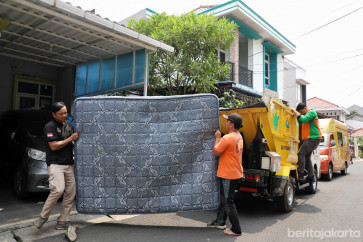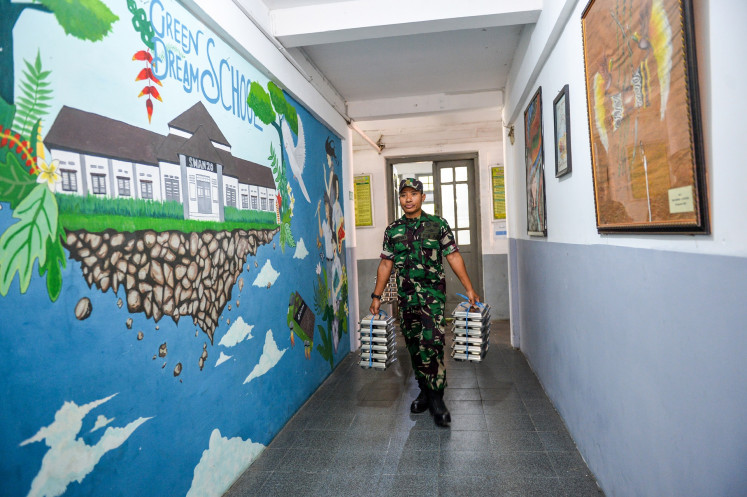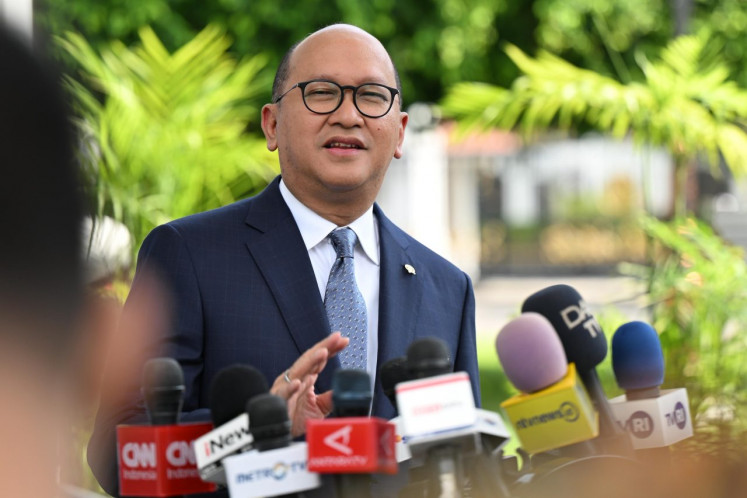Popular Reads
Top Results
Can't find what you're looking for?
View all search resultsPopular Reads
Top Results
Can't find what you're looking for?
View all search resultsIndonesia leaves northern frontier behind
According to estimates, Indonesia has more than 17,000 islands, making it the worldâs largest archipelago, but many of its outermost islands are poorly developed or uninhabited and the country faces challenges in safeguarding its borders
Change text size
Gift Premium Articles
to Anyone
According to estimates, Indonesia has more than 17,000 islands, making it the world's largest archipelago, but many of its outermost islands are poorly developed or uninhabited and the country faces challenges in safeguarding its borders. The Jakarta Post's Margareth Aritonang and Wendra Ajistyatama in collaboration with the Partnership for Governance Reform visited the Natuna and Anambas Islands regencies ' Indonesia's closest territories to the disputed South China Sea ' in Riau Islands to see how residents there live their lives and how the government supports them. Below is the first of a two part series on the two regions.
For those living on the island of Java, the nation's political and economic center, the regencies of Natuna and Anambas Islands are in the middle of nowhere.
Located some 1,300 kilometers north of Jakarta, the two regencies are found in the South China Sea, Indonesia's northernmost territory.
Bordering with neighboring Cambodia, Thailand, Malaysia and Vietnam ' the latter two of which are claimants of arguably the region's most disputed body of water ' Natuna and Anambas are part of Riau Islands province, the country's 32nd province after it separated from Riau province in 2002.
Both regencies formerly fell under the Natuna administration that comprised 392 islands, but Anambas became autonomous in 2008, taking 238 of those islands with it.
Only 26 of Anambas' total 238 islands, which are administered into seven subdistricts, are inhabited, while the rest are abandoned.
Similarly, the majority of the islands in the Natuna administration are also uninhabited, as local residents settled on only 27 islands while the remaining 127 are unpopulated, including the outermost islands, such as Kepala Island, Sebetul Island or Senua Island, which are adjacent to Malaysia and Vietnam.

It takes a huge effort to reach the two regencies due to their topography. They are reachable by a one-and-a-half-hour flight from the province's capital, Tanjung Pinang, or from the busiest and largest city in the province, Batam; or by traveling overnight via ferry, also from both cities.
However, access is so limited that one must set aside a few days to travel there.
Despite increasing demands for flights to both regencies, there are only three commercial flight services to Natuna per day because the regency has no commercial civil airport. Ranai Airport, the only existing airport there, is operated by the Indonesian Air Force (TNI-AU).
The situation is worse in Anambas. The absence of a commercial airport in Anambas has forced private commercial airline companies to use the airport operated by American energy company ConocoPhillips ' Matak Airport.
Consequently, commercial airlines must adjust their flight schedules to that of ConocoPhillips.
And if getting there is not difficult enough, the regencies also lack public transportation.
The only available on-island transportation services in Natuna are ojek (motorcycle taxis), privately rented cars and traditionally run boats, locally known as pompong due to the noisy sound of the boats' machines.
Despite their strategic position on the northern frontline of the archipelago and the abundant natural resources they hold, the regencies glaringly lack the basic infrastructures to enable them to play a strategic role.
Local residents believe Jakarta is not doing enough to boost development and security in their region, which they regard as 'the gate' of Indonesia.
'With a strong gate, a house will be safely protected. That said, if Indonesia wants to be safe, it should develop Natuna so it can be strong,' community leader Rodhial Huda told The Jakarta Post.
'Unfortunately, this country's border areas are disadvantaged, including Natuna,' he added.
Natuna and Anambas are among the 183 disadvantaged regions in Indonesia with high poverty rates, poor infrastructure and poor governance.
Both administrations recorded that almost 5 percent of the total population still lived in extreme poverty last year. According to the Central Statistics Agency's (BPS) local office, 76,305 people resided in Natuna in 2012 and 41,388 people in Anambas.
The conditions are far from people's aspirations, given the region's location and resources.
Close to the South China Sea, Natuna ' one the world's largest natural gas fields ' will be Indonesia's outermost defense line should territorial disputes over the South China Sea escalate.
China claims almost all the South China Sea, which stretches from China to Indonesia and from Vietnam to the Philippines.
ASEAN nations Vietnam, the Philippines, Brunei and Malaysia also claim parts of the sea.
Indonesia is not a claimant country but wants to play an active role in solving the disputes.
It has organized a raft of workshops, mostly informal discussions, to manage the potential conflict in the region and to promote cooperation among claimants since 1990.
Analysts, however, have said that it is becoming more difficult for Indonesia to retain its role as a neutral party in the disputed area.
In recent years, China has become more assertive with its modernized military and Indonesia's interests could be at stake as the former has also claimed part of its exclusive economic zone (EEZ) in Natuna.
With Natuna and Anambas still underdeveloped, concerns have been raised over whether Indonesia is prepared to deal with escalating conflicts in the north.
Natuna does not have a commercial harbor, let alone a military harbor, even though it is an archipelagic regency and most of its population comprises fishermen.
The regency is also without other basic facilities that could support the majority of local residents to make the most of abundant fishery resources, including a cool storage or a Fish Auction Center (TPI) where fishermen from all over the area can market their catches.
The local administration said it was waiting for the central government to change the situation.
'Our limited yearly budget [Rp 1.5 trillion] is only enough to cover basic infrastructure. We're focusing on constructing basic infrastructure. Thus, we cannot improve the tourist and maritime industries for the time being. This is where we need support from the central government,' Natuna Regent Ilyas Sabli said.
Anambas, where the majority of the population's livelihoods also depend on the sea, is in no better economic shape.
Having separated from Natuna for nearly five years with an average income of Rp 1.2 trillion (US$101 million) per year, the Anambas administration does not even have official offices to cater for 1,855 civil servants working in the 31 agencies.
The local administration still rents buildings from local residents to be used as government office buildings, with official government buildings still under construction.
'We will not be able to fully develop our region without help from Jakarta,' Ilyas Sabli said.










